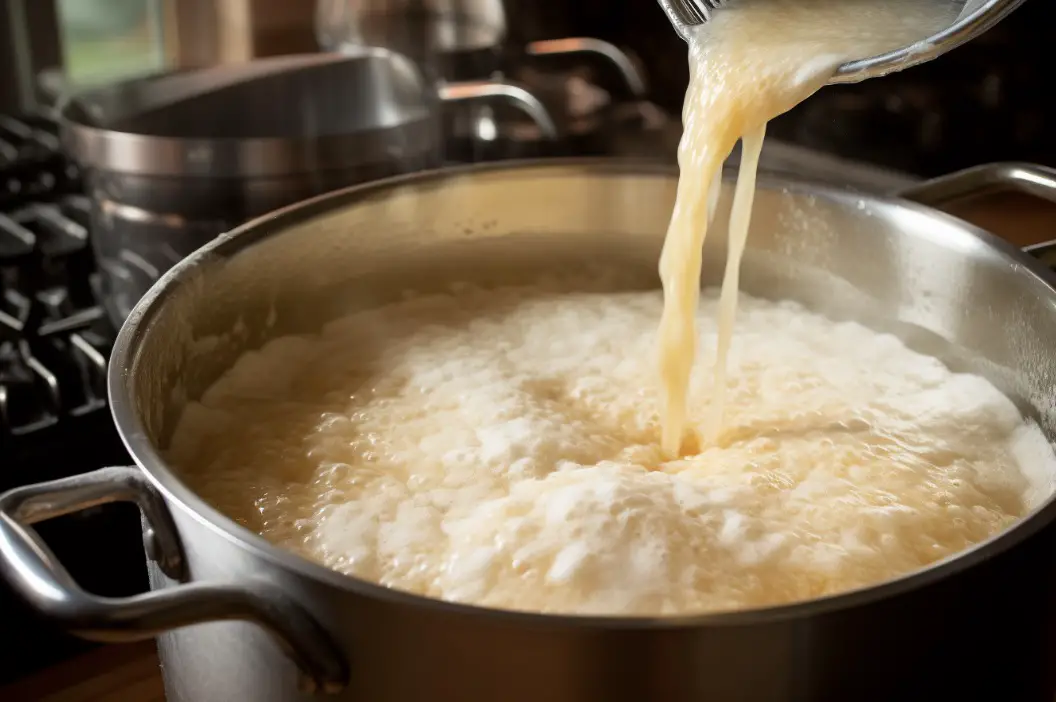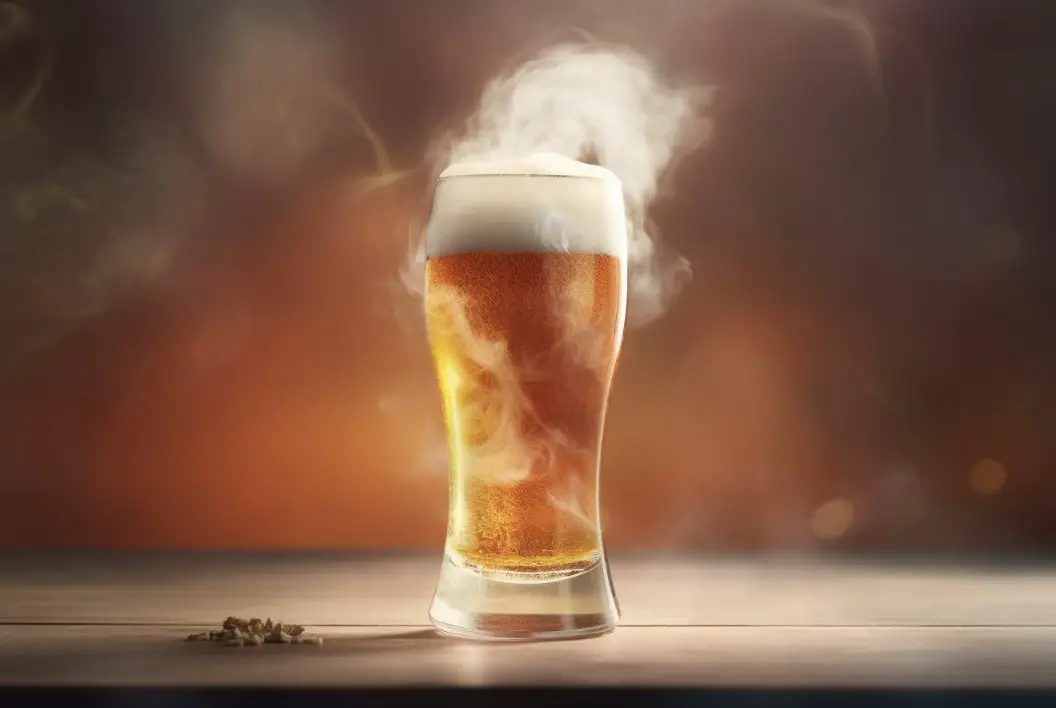Beer, a beloved alcoholic beverage made from fermented grains and hops, has been cherished for centuries. While beer crafting is relatively straightforward, it requires the addition of yeast to initiate the fermentation process.
Adding a significant amount of yeast to your brew at the outset can kickstart fermentation and expedite the beer-making process.
However, you must be cautious not to use too much yeast, as it may lead to overly rapid fermentation, resulting in foam, elevated temperatures, potential overflow, and undesirable off-flavors as the yeast exhausts itself.
In summary, while it’s acceptable to introduce a substantial amount of yeast to beer, moderation is key. It’s crucial to employ the appropriate yeast quantity and contemplate the addition of yeast nutrients to promote a healthy fermentation process.
So, grab your favorite beer mug, and let’s dive into the world of brewing!
The Ramifications of Excessive Yeast in Beer
Introducing an excessive amount of yeast to your beer can adversely affect its taste, aroma, and appearance.
An overgrowth of yeast can produce off-flavors and aromas, including an undesired increase in alcohol content, excessive foaming leading to overflow during fermentation, and a cloudy appearance in your brew. Regulating yeast levels is essential for elevating the quality of your beer.
When determining the right yeast quantity for beer fermentation, consider crucial factors such as yeast type, beer recipe, and fermentation temperature.
Using too much or too little yeast can result in undesirable outcomes, such as off-flavors, halted fermentation, and overcarbonation.
It’s important to remember that most yeast does not come from what you add at the beginning, but from what is formed by cell division during the fermentation process!

Yeast multiplication typically occurs around tenfold per day under ideal conditions, with the fastest growth at the beginning, eventually leveling out to an equilibrium phase where as many yeast cells die as divide.
For instance, if you add 1 gram of yeast to a 1-gallon (3.78 liters) container, assuming a maximum yeast density of 10^9 cells per ml (requiring yeast nutrient-rich wort), you’ll have approximately 50mg of yeast per ml at the peak of fermentation.
This equates to a final yeast mass of 0.05g x 3,785.41 milliliters, resulting in 189.27 grams of yeast mass at peak fermentation.
These are approximate calculations, but the key takeaway is that whether you start with 1 gram or 10 grams of yeast, you’ll end up with at least 200 grams (7 oz) per gallon (53 grams per liter) in a well-supported substrate.
The initial yeast quantity doesn’t significantly impact this number. However, it does affect the speed at which you reach that point.
If you are more interested in the mathematics behind yeast and fermentation speed, take a look at my slightly more nerdy post on whether adding more yeast will speed up fermentation (and how much!).
So, don’t fret too much about precise yeast measurements; you can save money by avoiding excessive yeast usage, and if needed, you can add more later if fermentation stalls.
Excessive Yeast and Its Impact on Beer Flavor
Introducing too much yeast to your beer can result in unpleasant off-flavors and aromas. An excess of yeast can overpower the natural beer flavors.
A substantial early yeast addition encourages rapid yeast cell breakdown, releasing metabolites, proteins, and DNA into the brew, all of which can influence the taste.

This can be especially problematic when using specific yeast strains to enhance beer flavor and aroma.
Additionally, an overzealous yeast presence can create aromas ranging from doughy or bready to sulfuric or reminiscent of rotten eggs.
Ultimately, excessive yeast can disrupt the delicate balance of beer flavors and aromas. Therefore, it’s vital to exercise caution when determining yeast quantities to avoid potentially adverse consequences.
Yeast Overgrowth and Higher Alcohol Content
When brewing beer, the amount of yeast you use is crucial, as excessive yeast can lead to undesired outcomes.
One such consequence is a higher alcohol content than intended. Yeast overgrowth can prolong fermentation, resulting in beer with a higher ABV than desired.
This can make the beer harsh and excessively alcoholic, detracting from the desired flavor profile. It’s essential to control yeast levels to achieve the desired taste and alcohol content in your beer.
By monitoring yeast quantities and fermentation time, you can ensure that your beer turns out just right.
Cloudy Appearance Caused by Excessive Yeast
If you’ve ever poured yourself a pint of beer and noticed it was hazy or cloudy, excess yeast may be the culprit. Too much yeast can cause your beer to become murky and unattractive.
Adding too much yeast at the beginning can also speed up fermentation (to a certain point…), which may increase the risk of krausen blowouts (over foaming) if the temperature is too high or the fermenter too small.

Moreover, clumps of dead yeast may accumulate over time, especially with a generous yeast addition.
This not only affects appearance but can also introduce off-flavors and aromas. Precise yeast control is paramount for producing high-quality beer. It’s crucial to determine the appropriate yeast pitching rates for your beer batch.
Using too much or too little yeast can result in consequences like an undesired alcohol content. In the end, the right yeast quantity will yield a clear and refreshing glass of beer.
Timing Matters When Adding Yeast to Beer
When it comes to brewing beer, timing plays a pivotal role in achieving the perfect balance of flavors and aromas. When deciding when to add yeast to your beer, consider the temperature and acidity of your wort.
Beer yeast thrives at temperatures between 60-75°F, so ensure your wort falls within this range before introducing yeast. Additionally, adequate acidity levels in your wort promote healthy yeast growth. Once your wort reaches the correct temperature and acidity, it’s time to add your chosen yeast strain.
Be mindful of the quantity you introduce, as excess yeast can lead to higher alcohol content and off-flavors.
In conclusion, the key to successful beer fermentation lies in balance—a suitable yeast quantity added at the right time can result in a delightful and well-rounded finished product.
Reviving Ailing Beer with Proper Acidity and Additional Active Yeast
If your beer doesn’t taste right or has ceased fermenting, it may be “sick” due to an acidity imbalance or excessive metabisulfite usage, rendering the yeast inactive.

But fear not! By introducing the right amount of extra active yeast and adjusting acidity levels, you can revive your beer and bring it back to life.
First, assess your beer’s acidity using a pH meter or acid test strips, and adjust as necessary with sodium bicarbonate (baking soda) or calcium. Ensure the pH is not lower than 3 by adding alkalizing agents until it surpasses a pH reading above 3.
Then, introduce a small quantity of active yeast to kickstart fermentation and ensure a clean, consistent flavor profile.
If the issue is excessive sulfite, “air out” your beer by gently transferring it between two vessels. This is best done when the beer is stuck at the early stages of fermentation, as prolonged oxygen exposure is not ideal for advanced fermentation stages.
With proper care and attention, even “sick” beer can be salvaged and transformed into a delicious, refreshing beverage to savor.
Controlling Yeast Levels for Better Beer Quality
Effective control of yeast levels in your beer can significantly enhance its overall quality. As mentioned earlier, excessive yeast can lead to off-flavors, higher alcohol content, and a cloudy appearance.
Conversely, using too little yeast can result in incomplete fermentation and a lack of desired flavors. By meticulously managing yeast quantities in your beer, you can strike a balance that enhances the natural flavors of your ingredients while achieving a desirable alcohol content.
Additionally, controlling yeast levelscan help prevent spoilage and other pitfalls in the beer-making process. Therefore, don’t underestimate the significance of proper yeast control when striving to produce high-quality beer that is both delectable and consistent.
How Much Yeast Should You Use for Beer?
The ideal yeast quantity depends on the volume of beer you are producing, the desired alcohol content, and the yeast strain employed.
Generally, 1 gram of yeast per gallon of beer is adequate. However, for a drier, higher-alcohol, or challenging-to-ferment beer, 2-3 grams per gallon may be suitable.
It’s essential to remember that most yeast cells arise from cell division during fermentation, not solely from the initial yeast addition.
Finding the right yeast pitching rate will enhance the overall quality of your beer. To ensure a successful fermentation process, add yeast when your wort is at room temperature and seal it with a stopper and airlock.
In summary, moderation is key when dealing with yeast in beer production.
Factors to Consider When Determining Yeast Pitching Rates
When determining the appropriate yeast quantity for your beer, several factors come into play. As previously mentioned, using too much yeast can lead to off-flavors, higher alcohol content, and a cloudy appearance.
Conversely, too little yeast can result in sluggish fermentation or a stuck fermentation.
Consider your beer’s volume, specific gravity, and the desired alcohol content when determining your yeast pitching rate.
Additionally, bear in mind that different yeast strains can have varying effects on your beer’s taste and aroma.
By carefully considering these factors, you can ensure the optimal yeast pitching rate for top-quality beer.
Potential Consequences of Using Too Much or Too Little Yeast in Beer Production
Utilizing excessive or inadequate yeast in beer production can negatively impact your brew’s overall quality. Overusing yeast can result in off-flavors and aromas, as well as a higher alcohol content than desired.
This can also lead to a cloudy beer appearance. On the other hand, using too little yeast can lead to sluggish fermentation and potentially unhealthy bacterial growth.
Pros of Using Small Amounts of Yeast in Beer Brewing:
- Enhanced Yeast Character: Small yeast quantities can lead to a more pronounced yeast character, allowing the unique flavors and aromas of the yeast strain to shine through.
- Subtle and Complex Profiles: Lower yeast populations can result in a beer with subtle and complex flavor profiles, ideal for certain styles like Belgian ales or saisons.
- Extended Fermentation: Small yeast populations may lead to longer fermentation times, which can contribute to the development of intricate and well-rounded flavors.
- Reduced Cost: Using less yeast can be cost-effective, as you’ll need to purchase fewer yeast packets or perform fewer yeast starters.
Cons of Using Small Amounts of Yeast in Beer Brewing:
- Risk of Stuck Fermentation: Small yeast populations are more prone to stuck fermentations, which can leave you with incomplete or under-attenuated beer.
- Longer Wait Times: Extended fermentation periods can increase the time it takes to brew a batch of beer, testing your patience.
- Inconsistent Results: Achieving consistent results with small yeast quantities can be challenging, as variations in fermentation may lead to different outcomes with each batch.
- Limited Styles: This approach is best suited for certain beer styles, and using very small yeast amounts may not be suitable for all types of beer.
Pros of Using Large Amounts of Yeast in Beer Brewing:
- Faster Fermentation: Large yeast populations lead to faster and more vigorous fermentations, reducing the time needed to brew a batch of beer.
- Predictable Results: Using ample yeast provides more consistency, making it easier to reproduce the same beer characteristics from batch to batch.
- Lower Risk of Stuck Fermentation: With an abundance of yeast, the risk of a stuck fermentation is minimized, ensuring complete attenuation.
- Versatility: Large yeast quantities can be beneficial for a wide range of beer styles, from clean lagers to robust stouts.
Cons of Using Large Amounts of Yeast in Beer Brewing:
- Masked Yeast Characteristics: Excessive yeast populations can overpower the yeast’s unique flavors with a general “yeasty” flavor, resulting in a less distinct yeast character.
- Limited Complexity: Some beer styles, especially those that rely on yeast-driven complexity, may lose subtlety and nuance when subjected to an abundance of yeast.
- Costlier: Using larger yeast quantities may be more expensive, as it requires more yeast packets or larger yeast starters.
- Higher Risk of Off-Flavors: Rapid fermentation from excessive yeast can produce undesirable off-flavors or stress the yeast, potentially affecting the beer’s quality.
Determining the appropriate yeast quantity depends on several factors, including the desired alcohol content, temperature, and sugar levels in your wort.
By effectively controlling yeast levels, you can enhance the overall quality of your beer and ensure a successful fermentation process.
Conclusion
In the world of beer crafting, yeast management plays a pivotal role in shaping the quality, flavor, and appearance of your brew. Whether you’re aiming for a crisp lager or a robust ale, finding the right balance in yeast quantity and timing is essential. Here are the key takeaways to remember:
Key Takeaways:
- Moderation is Key: Avoid excessive yeast, as it can lead to off-flavors, high alcohol content, and a cloudy appearance.
- Timing Matters: Pay attention to the temperature and acidity of your wort before adding yeast to achieve a well-rounded flavor and aroma profile.
- Reviving Sick Beer: Don’t give up on ailing beer – adjust acidity and introduce extra active yeast to bring it back to life.
- Yeast Control Improves Quality: Careful yeast management enhances the natural flavors and consistency of your beer.
- Proper Pitching Rates: Consider factors like volume, specific gravity, and yeast strain when determining the right yeast quantity for your brew.
By following these guidelines, you’ll be well on your way to mastering the art of brewing, ensuring your beer not only quenches your thirst but also delights your palate. Cheers to a world of flavorful and well-crafted beers!
References
- https://journals.plos.org/plosone/article?id=10.1371/journal.pone.0188388
- https://www.homebrewtalk.com/threads/fellow-cider-makers-how-much-yeast-is-too-much.483507/
- https://www.reddit.com/r/Homebrewing/comments/j00v0o/added_too_much_yeast_to_my_cider_did_i_ruin_it/
- https://www.quora.com/Will-adding-more-sugar-or-yeast-to-my-homemade-cider-give-it-a-higher-alcohol-content-or-just-ruin-it
- https://tarbarrel.com.au/what-happens-if-you-add-too-much-yeast-to-your-brew/




